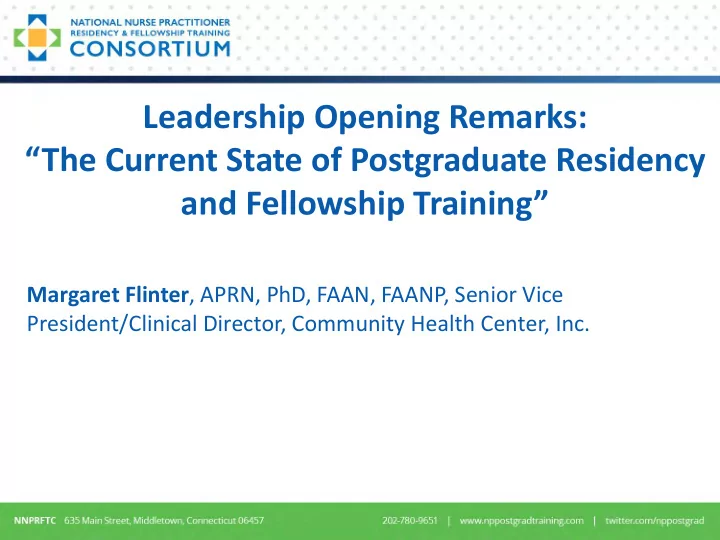

Leadership Opening Remarks: “The Current State of Postgraduate Residency and Fellowship Training” Margaret Flinter , APRN, PhD, FAAN, FAANP, Senior Vice President/Clinical Director, Community Health Center, Inc.
LEARNING OBJECTIVES : 1. Participants will understand the history of Postgraduate Residency and Fellowship Training 2. Participants will learn about current trends in postgraduate training. 3. Participants will understand the importance of postgraduate residency and fellowship training.
Where we’ve been: the first decade of Postgraduate NP Residency Training Programs
Today: Primary Care, Specialty and Sub-Specialty NP/PA Postgraduate Training Programs – Total 241 Programs Nationally
Primary Care, Specialty and Sub-Specialty NP/PA Postgraduate Training Programs Nationally, the 241 NP Residency Programs offer a range of 50 specialty and sub-specialty program areas.
Primary Care, Psychiatric/MH and Specialty Postgraduate Training Programs
In June 2019, HRSA awarded 36 grants to entities in 24 states to increase primary care providers in community-based settings. Eight awards were for new programs; twenty eight were to expand existing programs. In April 2020, HRSA issued a Notice of Funding Opportunity for the Advanced Nursing Education Nurse Practitioner Residency Integration Program (ANE-NPRIP) to enhance existing programs.
The National Training and Technical Assistance Partners (NTTAP) funded by the Health Resources and Services Administration, and hosted by CHCI/ Weitzman Institute is an evidenced- based model designed to provide transformational strategies and coaching support to help FQHCs implement postgraduate residency programs. 46 NTTAP Learning Collaborative participant organizations- 63% have launched programs 14 organizations plan to launch programs in 2021
Trends in Postgraduate Training • Expansion from one “track” to multiple tracks • Multiple cohort admissions per year • Growth across all domains: primary care, specialty care, and in-patient acute care. • Growth in psychiatric/mental health programs within primary care settings • Development of formal academic partnerships • New emphasis on telehealth/virtual care
….AND THEN CAME THE SPRING OF 2020
What do you (clinicians) think of quality of care? Considering the circumstances, my patients receive the same quality of care during a video/phone visit as an office visit. Video (n = 91) 12% 30% 22% 22% 14% Telehealth Technology Phone (n = 235) 10% 31% 25% 21% 13% 0% 10% 20% 30% 40% 50% 60% 70% 80% 90% 100% Opinions Strongly Agree Agree Neutral Disagree Strongly Disagree
What do you (patients) think about your care? April – June 2020
Thank you. For more information, please contact: Margaret Flinter , APRN, PhD, FAAN, FAANP SVP and Clinical Director, Community Health Center, Inc. and Founder, CHCI’s Weitzman Institute for Research, Innovation, and Training 635 Main Street, Middletown, CT 06457 margaret@chc1.com Office: 860. 852.0899
Recommend
More recommend